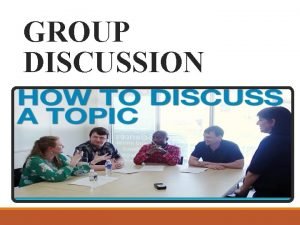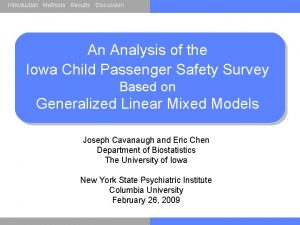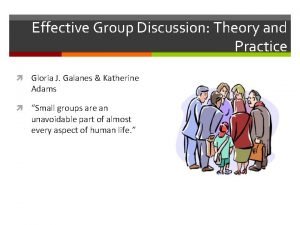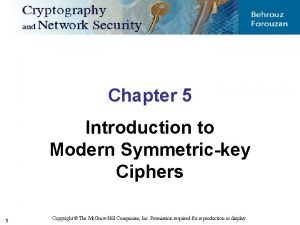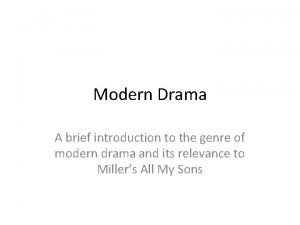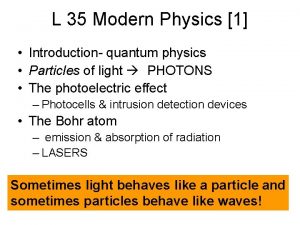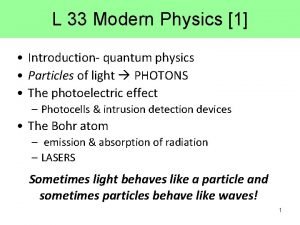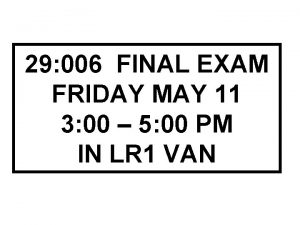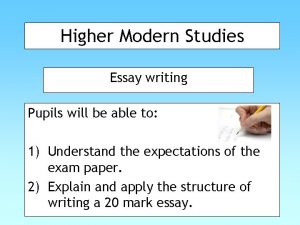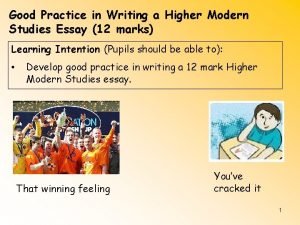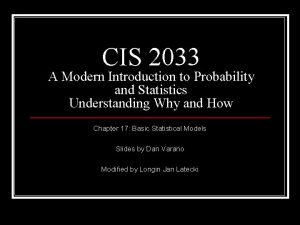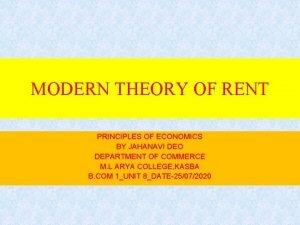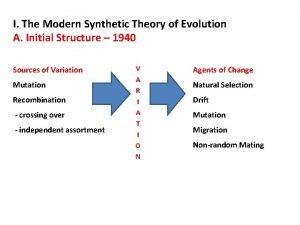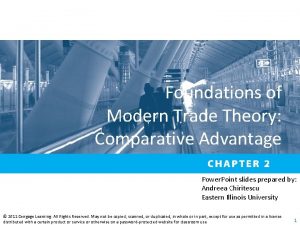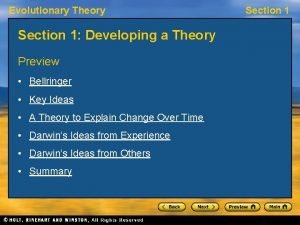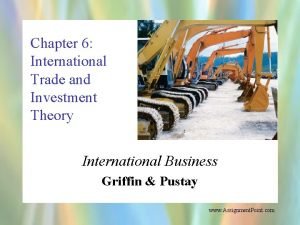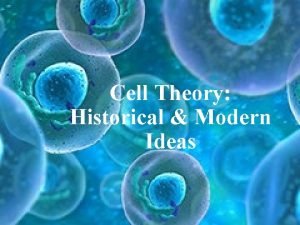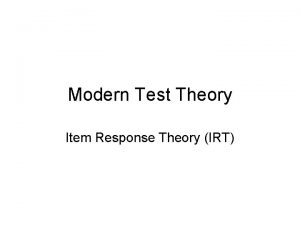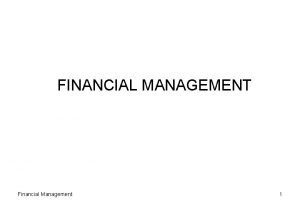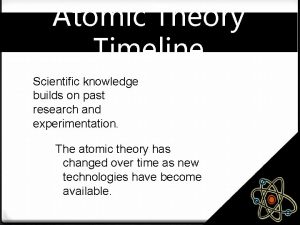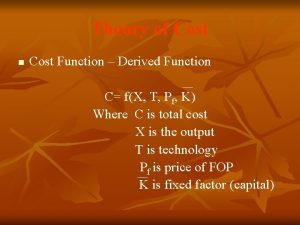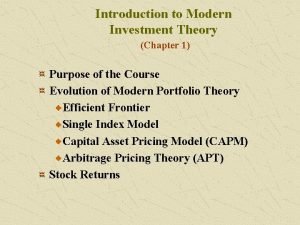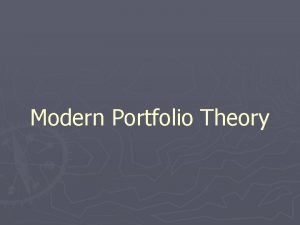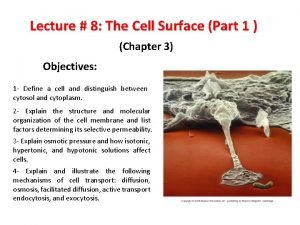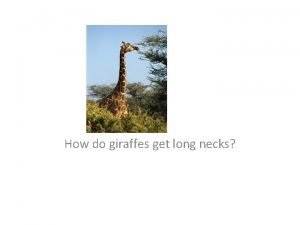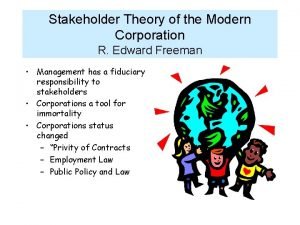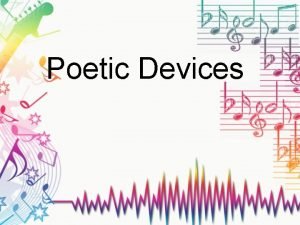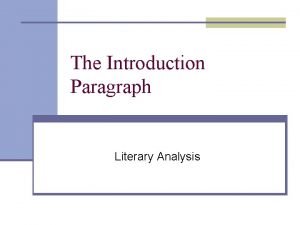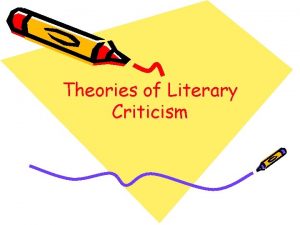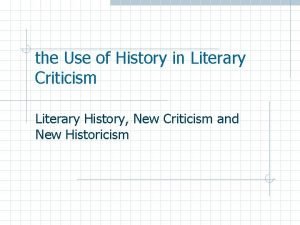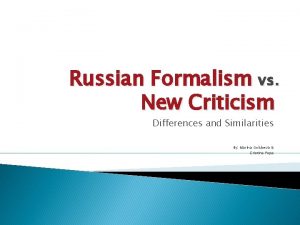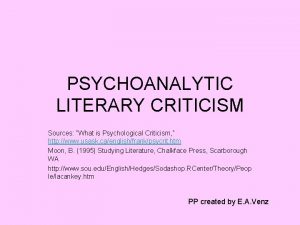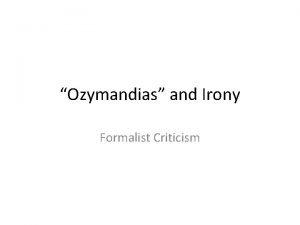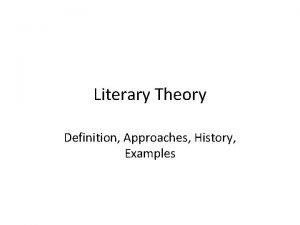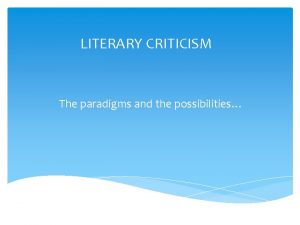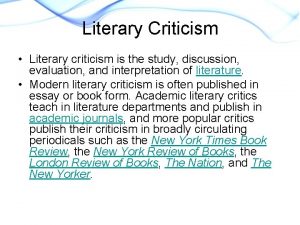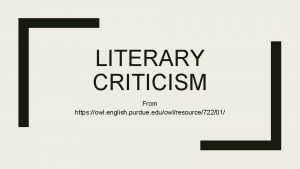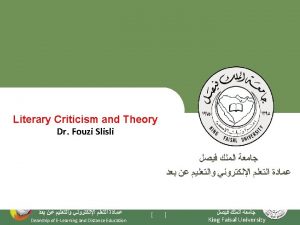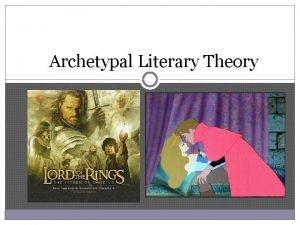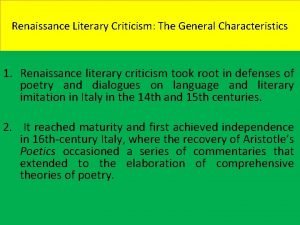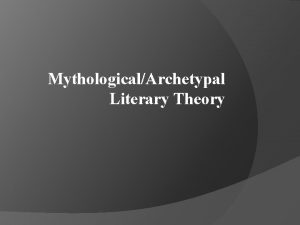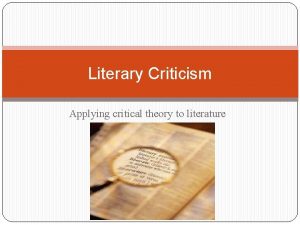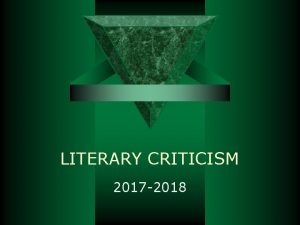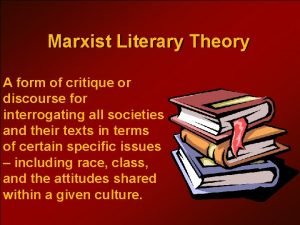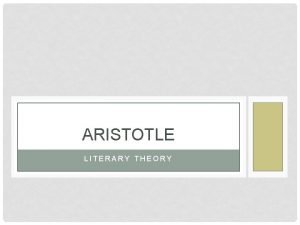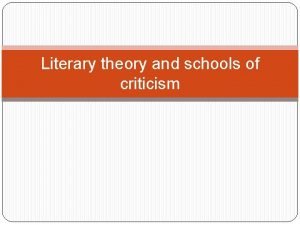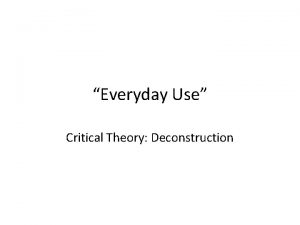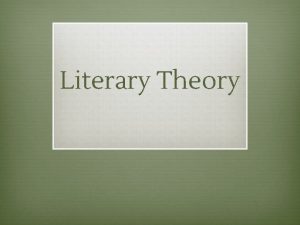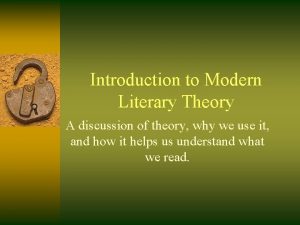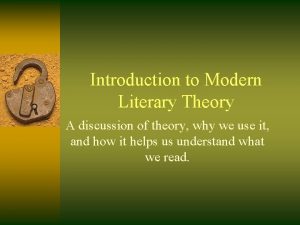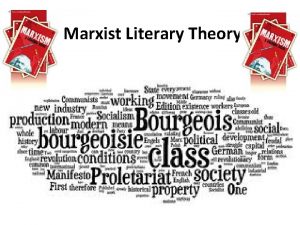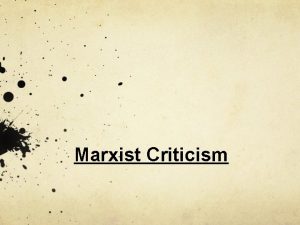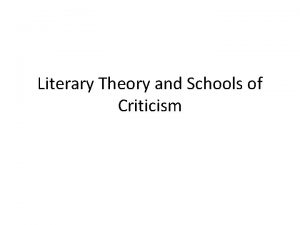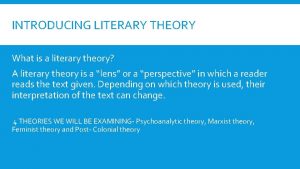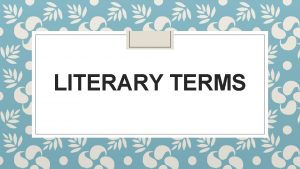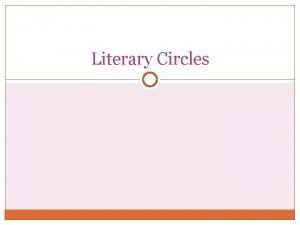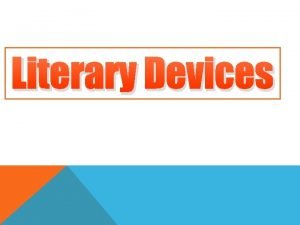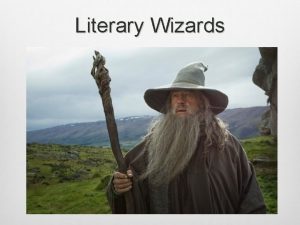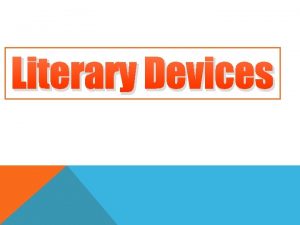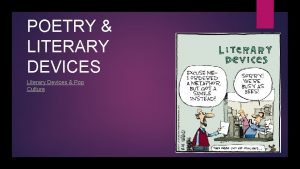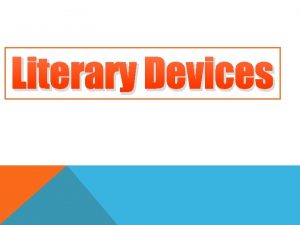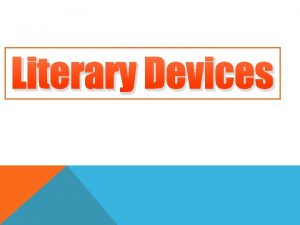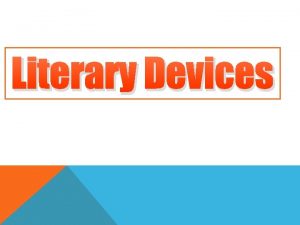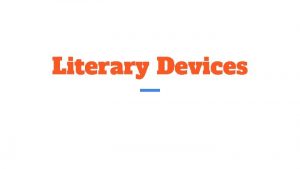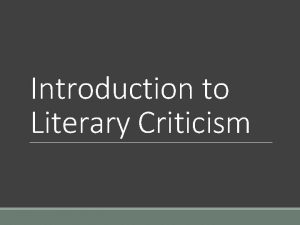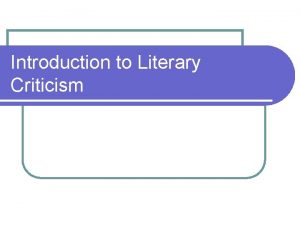Introduction to Modern Literary Theory A discussion of





















































- Slides: 53

Introduction to Modern Literary Theory A discussion of theory, why we use it, and how it helps us understand what we read.

A Good Analogy: ¨Examine the ink blots on the next slides. ¨What do you see in the image? Write down a short explanation of what you see. ¨Be prepared to share.




What is modern theory? ¨ In the study of literature, “theory” has traditionally referred to a set of general principles that can be used to classify or otherwise analyze a literary work. In some cases, theory is used to interpret or even evaluate texts. ¨ A critical essay may not clearly ground itself in a particular literary theory, but some general theory or set of assumptions about literature is implied in most interpretations or analyses. ¨ Theory changes with time and new theories are always being added to the traditional

What Theory Tries to Explain: ¨What is literature? ¨How is it produced? ¨How can it be understood? ¨What is its purpose?

Why we study theory Literary criticism has two main functions: 1. To analyze, study, and evaluate works of literature. 2. To form general principles for the examination of works of literature.

Common Characteristics of Theory M. H. Abrams points out in The Mirror and the Lamp that “any reasonably adequate theory takes some account of. . . four elements” (6). These elements are 1. The work itself 2. The artist who creates the work 3. The universe or the nature that is being imitated by the work 4. The audience of the work

Keep an Open Mind ¨ As we discuss these, you may find yourself agreeing with one or two theories while disagreeing heartily with another. Keep in mind that no single theory offers the “right” answer about a work of literature; good literature is simply too varied. Keeping an open mind and listening to other points of view can enrich your own insights; that is the purpose of criticism.

Perspective Literary interpretation is often influenced by a person’s perspective. For instance, a female may have a very different reaction to Their Eyes Were Watching God than a male reader It’s all about how YOU, the reader, views a certain text. What perspective are you bringing to the table? The truth is, there is no one correct way!

Psychoanalytic Criticism ¨ Applying the principles of ¨ Most of the time the focus is on motivation or psychologists like Sigmund character development Freud and Jung to a literary ¨ Often themes deal with work psychological issues, such ¨ Analyzing characters as growing up/ coming of within the work age and how humans deal ¨ Analyze writer’s psyche, with loss and love writing process, or the influence of the writer’s thoughts on the novel ¨ Effects of literature on readers

Key Terms: • Jungian Approach: ¨ Freud's model of the • Three parts of self · -Shadow (dark part of self) psyche: Id - completely unconscious part of the psyche that serves as a storehouse of our desires, wishes, and fears. The id houses the libido, the source of psychosexual energy. Ego - mostly to partially conscious part of the psyche that processes experiences and operates as a mediator between the id and superego. Superego - often thought of as one's "conscience"; the superego operates "like an internal censor [encouraging] moral judgments in light of social pressures" (Bressler) -Persona (social part of personality) -Anima (man’s “soul image”) Neurosis occurs when someone fails to assimilate one of these levels of unconsciousness into his or her conscious and projects it onto someone else.

Key Terms: (cont…) ¨ Unconscious - the irrational part of the psyche unavailable to a person's consciousness except through dissociated acts or dreams.

Advantages and Disadvantages ¨ Advantages ¨ Disadvantages ¨ Can help understand ¨ Makes literature a works with characters who have obvious psychological issues ¨ Helps us understand the writer’s mind and therefore his work ¨ Helps us connect with characters and works scientific case study ¨ Can we psychologically analyze dead writers? ¨ Sexuality is overdone

Examples: ¨ In Metamorphosis, Gregor is dealing with an existential crises because he has not assimilated what his anima desires into his persona. His shadow is his bug form, secretly ditching out on his obligatory life ¨ Inside Out by Disney Pixar- the main character is suffering from depression due to a move and likely due to hormonal imbalances, and the voices in her head try to guide her back to happiness (Id, Ego)

Examples Part II: ¨ Little Miss Muffet has arachnophobia and therefore when her life is disturbed by the presence of a spider, she cannot truly enjoy her breakfast. Her irrational fear is interfering with her happiness and health.

Visual Support

New Criticism ¨ Takes a text as an ¨ It is what we do with autonomous object, non-related to the author, the culture, or the event it stems from ¨ Explores the “world” within the text ¨ Started in 1920’s and 1930’s AP Literature!! Each prompt uses this idea to close read the textual excerpt. ¨ We don’t always study background or history prior to reading novels, either.

KEY TERMS: ¨ Intentional Fallacy - equating the meaning of a poem with the author's intentions. ¨ Affective Fallacy confusing the meaning of a text with how it makes the reader feel. A reader's emotional response to a text generally does not produce a reliable interpretation. ¨ Heresy of Paraphrase assuming that an interpretation of a literary work could consist of a detailed summary or paraphrase. ¨ Close reading "a close and detailed analysis of the text itself to arrive at an interpretation without referring to historical, authorial, or cultural concerns" (Bressler)

Advantages and Disadvantages ¨ Advantages - Do not have to know the author’s background -Do not have to be familiar with historical context -Can analyze language and imagery… ¨ Disadvantages -Text seen in isolation -Cannot account for allusions -Ignores context of work -Reduces literature to a series of literary devices

Examples: ¨ Hard to show, but when we reread the passage from Their Eyes Were Watching God of Janie under the pear tree ¨ When you study a single scene in a movie looking for its meaning (like a trailer!) ¨ We would never understand the historical precedence of “Ring Around the Rosie”- but who cares, because we like the rhyme and the actions of falling down

Visual Aid:

Marxism ¨ Sees art and literature as forced by the conditions that existed in history ¨ Deals with clash between classes ¨ Articulation of dominant class ¨ Art reflects age in which it was created ¨ Suggested Websites: ¨ "Definition of Marxist Criticism" - virtua. Lit (Bedford-St. Martin's resource) ¨ Marxist Theory and Criticism - from the Johns Hopkins Guide to Literary Criticism ¨ "Marxism and Ideology" by Dr. Mary Klages University of Colorado at Boulder

Key Terms: ¨ Material circumstances - the economic conditions underlying a society ¨ Commodification – Wanting thing not for ¨ Reflectionism - their use but their superstructure of a ability to impress others society mirrors its or to sell economic base and, by extension, that a text ¨ Conspicuous reflects the society that consumption – produced it Getting things merely for selling or trading ¨ Superstructure - The social, political, and ¨ Dialectical ideological systems and materialism – the institutions that are eternal struggle to find a generated by the people solution among conflicting ideologies to bring about change

Advantages and Disadvantages ¨ Advantages ¨ Look at the work in ¨ Disadvantages ¨ Have to be aware of the context it was the culture and written economic system in place when written ¨ Allows you to research and understand the ¨ Have to assume “the culture more man” was out to get the people ¨ Can see multiple perspectives from ¨ Has to be a class dominant and conflict, not race or dependent classes gender (class matters most)

Example ¨ What is a major class conflict that you have seen in a movie or read in literature recently? What was the dominant class’ point of view? What was the inferior class’ point of view? Briefly analyze how this conflict was resolved or how it should have been resolved using Marxist theory.

Reader-Response Theory ¨ Analyzes reader’s role in production of meaning ¨ Text itself means nothing until someone reads it ¨ Reading is a function of personal identity ¨ Authors use strategies to elicit responses from readers ¨ Suggested Websites: ¨ "Reader Response: Various Positions" - Dr. John Lye - Brock University ¨ Reader Response Theory and Criticism Johns Hopkins Guide to Literary Theory & Criticism ¨ "The Author, the Text, and the Reader" Clarissa Lee Ai Ling, The London School of Journalism

Key Terms: ¨ Horizons of expectations - a reader's "expectations" or frame of reference is based on the reader's past experience of literature and what preconceived notions about literature the reader possesses ¨ Implied reader - the implied reader is "a hypothetical reader of a text”, a construct that is unrelated to the “real” reader -Developed by Wolfgang Iser ¨ Interpretive communities - a concept, articulated by Stanley Fish, that readers within an "interpretive community" share reading strategies, values and interpretive assumptions ¨ Transactional analysis - a concept developed by Louise Rosenblatt asserting that meaning is produced in a transaction of a reader with a text. As an approach, then, the critic would consider "how the reader interprets the text as well as how the text produces a response in her"

Advantages and Disadvantages ¨ Advantages ¨ Disadvantages ¨ No one interpretation ¨ Can be too subjective ¨ Interpretations change ¨ No clear criteria to over time account for differences from one reader to the next ¨ Highly personal at times

Postmodernism ¨ For Jean Baudrillard, postmodernism marks a culture composed "of disparate fragmentary experiences and images that constantly bombard the individual in music, video, television, advertising and other forms of electronic media. The speed and ease of reproduction of these images mean that they exist only as image, devoid of depth, coherence, or originality"

Postmodernist Theories: ¨ Deconstruction ¨ Hermeneutics ¨ Semiotics

Deconstruction: ¨ Sees literature as fluid parts and not one whole, with multiple meanings and ways to look at and not one large meaning. ¨ Infinite number of signifiers ¨ Deconstruction - Stanford University ¨ Deconstruction - Johns Hopkins Guide to Literary Theory & Criticism

Hermeneutics: ¨ Sees interpretation as a circular process whereby valid interpretation can occur by seeing the literary work as a whole and as a combination of its parts ¨ Can analyze the historical authorial intent and at the same time the language within the text to gain understanding ¨ Phenomenology Online - page developed by Max van Manen

Semiotics: ¨ The science of signs ¨ Proposes that human actions and productions have shared meaning to a group of people ¨ Linguistics is a branch of semiotics ¨ "Semiotics for Beginners" - Dr. David Chandler (University of Wales) ¨ Semiotics - Johns Hopkins Guide to Literary Theory & Criticism

Signified and Signifier ¨ Sign vs. Symbol - According to Saussure, "words are not symbols which correspond to referents, but rather are 'signs' which are made up of two parts: a mark, either written or spoken, called a 'signifier, ' and a concept (what is 'thought' when the mark is made), called a 'signified‘”. ¨ Meaning--the interpretation of a sign--can exist only in relationship with other signs. (I. e. The stoplight color red signifies "stop, " even though "there is no natural bond between red and stop“) (105). ¨ Meaning is derived entirely through difference, e. g. , referring back to the traffic lights' example, red's meaning depends on the fact that it is not green and not amber

Feminism ¨ Concerned with impact ¨ Suggested Websites: of gender on writing and ¨ reading ¨ Desire for a new literary canon (not men) ¨ ¨ Deals with conflicts between often dominate male and inferior female in traditional literature ¨ Deals with female issues ¨ Approaches to Feminism - Stanford Encyclopedia of Philosophy "What is Feminism and Why Do We Have to Talk About It So Much? " by Dr. Mary Klages - University of Colorado at Boulder Feminist Theory: An Overview - Elixabeth Lee - The Victorian Web

Key Terms: ¨ Androgeny- world without genders ¨ Écriture féminine- style, women must write about their experiences to strengthen the work ¨ Essentialism- a female image above and beyond social constructs ¨ Phallologocentrism - language ordered around an absolute Word (logos) which is “masculine” [phallic], systematically excludes, disqualifies, denigrates, diminishes, silences the “feminine”

Advantages and Disadvantages ¨ Allows for more female authors’ works to be read ¨ Get to see an alternative perspective in literature ¨ Understand women more ¨ Not all “dead white men” ¨ Disadvantages ¨ Often attack works solely based on male authorship ¨ Often too theoretical ¨ Distinct female style often excludes elements that get novels into the canon

Example ¨ Look at a novel by Barbara Kingsolver from the feminist perspective, whether it be The Bean Trees or Poisonwood Bible. What elements exist to show this political battlefield that often exists in feminist literature. List characteristics that make the novel feminist.

Historical/Cultural Criticism A. K. A. New Historicism ¨ Takes the work and looks at it in context of the world it came out of (opposite of New Criticism) ¨ Good to use for Shakespearean works as well as older works, to gain more understanding of authors and impact ¨ Analyzes historically accurate influences on author and storyline. ¨ Sources -Any sight that deals with the history of the time period a novel, play, or poem was written in

Key Terms: ¨ The intentional fallacy: meaning of a work is determined by author’s intention

Advantages and Disadvantages ¨ Advantages ¨ Disadvantages ¨ To fully understand works ¨ Reduces art to level of by some authors, one must biography be able to understand where they are coming from. For ¨ Works not necessarily example, Milton was blind seen as universal and one must know that to ¨ Can date certain works get any meaning out of his (feel not as applicable essay “On His Blindness” to modern life. ) ¨ Necessary to place allusions in appropriate context ¨ Good to recognize patterns

Example ¨ Choose a text that you have recently read and are familiar with. What was your personal response to that text? Why did you react the way you did while reading it? What did you see in the text that caused you to react in one way or another?

Existentialism ¨ Philosophy (Satre and Camus) that views each person as an isolated being thrust into a universe with no truths, values, or meanings ¨ Nothing to nothing ¨ All choices possible ¨ Absurd anguished ¨ Condemned to be free ¨ Suggested Websites: ¨ "Existentialism" - Stanford Encyclopedia of Philosophy ¨ "The Ethics of Absolute Freedom" by Dr. David Banach ¨ "Jean-Paul Sartre: The Humanism of Existentialism" by Dr. Bob Zunjic (University of Rhode Island)

Key Terms: ¨ Absurd - a term used to describe existence--a world without inherent meaning or truth. ¨ Authenticity - to make choices based on an individual code of ethics (commitment) rather than because of societal pressures. A choice made just because "it's what people do" would be considered inauthentic. ¨ "Leap of faith" - although Kierkegaard acknowledged that religion was inherently unknowable and filled with risks, faith required an act of commitment (the "leap of faith"); the commitment to Christianity would also lessen the despair of an absurd world.

Advantages and Disadvantages ¨ Advantages ¨ Disadvantages ¨ Ultimate choice is the ¨ Confined by constructs character’s, no external pull ¨ Potential explanation for need for religion of society ¨ Can drive you insane ¨ Why are we here then? ¨ I might as well just die

Post-colonialism ¨ School of thought that existed in the post. European empire period, the body of theoretical literature that existed in that time ¨ Takes us back to time and place to examine works (resurrect culture) ¨ Free from modern constructs of history ¨ Suggested Websites: ¨ "Post-Colonialism" - Wikipedia Encyclopedia ¨ "Some Issues in Postcolonial Theory" by Dr. John Lye (Brock University) ¨ "Introduction to Postcolonial Studies" by Dr. Deepika Bahri (Emory University)

Key Terms: ¨ Alterity – Being different ¨ Hybridity - The assimilation than one’s community and adaptation of cultural ¨ Diaspora- Being forced as practices, the crossan ethnic culture to leave fertilization of cultures; can original homeland be seen as positive, enriching, dispersed throughout world and dynamic, as well as as oppressive ¨ Eurocentrism –an emphasis on European or ¨ Imperialism- If you don’t Western beliefs, often at know it I don’t know expense of other cultures. you… Aligned with current and past power structures in the world.

Advantages and Disadvantages ¨ Advantages ¨ Forces us to look at ¨ Disadvantages ¨ Hard to completely lost cultures and the remove from modern origins of alternative realm cultures (non-Western) ¨ Have to assume there ¨ Considers literature in is an oppressed people context and therefore in order to use makes it easier to understand at times ¨ Cannot apply to all Western works

Example ¨ Consider some of the American Literature that you read last year. Was any of it from a perspective other than a colonist? A European? A white male? Were there any characters that stood out as not fitting into their culture or society? How or why?

So… ¨ Now you have the basics, and when I say that I mean BARE minimum you need to know to begin to understand the literary criticisms you will become familiar with this year. Keep your notes as we will refer back to them often, as we read literary criticisms of the novels we read and as we start to analyze literature ourselves. ¨ YOU HAVE THE KEYS, unlock the doors

Sources: ¨ Dr. Kristie Siegel www. kristisiegel. com/theory. htm ¨ Skylar Hamilton Burris “Literary Resources Criticism” http: //editorskylar. tripod. com ¨ www. theory. org. uk ¨ Richter, David H. (2000). Falling Into Theory. Boston: Bedford/St. Martins.
 Simple distillation
Simple distillation Group discussion vs debate
Group discussion vs debate Introduction methods results discussion conclusion
Introduction methods results discussion conclusion Effective group discussion defines human communication as
Effective group discussion defines human communication as Literary elements vs literary devices
Literary elements vs literary devices Introduction to modern symmetric key ciphers
Introduction to modern symmetric key ciphers Introduction to modern drama
Introduction to modern drama Concepts of child care
Concepts of child care Modern concept of child care slideshare
Modern concept of child care slideshare Modern physics
Modern physics Modern physics introduction
Modern physics introduction Modern physics introduction
Modern physics introduction Higher modern studies 20 mark essay examples
Higher modern studies 20 mark essay examples Advanced higher modern studies essay examples
Advanced higher modern studies essay examples A modern introduction to probability and statistics
A modern introduction to probability and statistics Features of modern theory of rent
Features of modern theory of rent Modern theory of rent
Modern theory of rent Modern synthetic theory of evolution notes
Modern synthetic theory of evolution notes Modern theory of trade
Modern theory of trade Modern evolution theory
Modern evolution theory Eclectic theory
Eclectic theory Modern cell theory
Modern cell theory Modern portfolio theory
Modern portfolio theory Modern test theory
Modern test theory Modern corporate finance
Modern corporate finance Democritus atomic theory model
Democritus atomic theory model Traditional theory of cost
Traditional theory of cost Modern investment theory
Modern investment theory History of modern portfolio theory
History of modern portfolio theory Modern cell theory
Modern cell theory Lamarck theory of evolution notes
Lamarck theory of evolution notes Stakeholder theory of the modern corporation
Stakeholder theory of the modern corporation Introduction to poetry by billy collins
Introduction to poetry by billy collins Introduction paragraph for literary analysis
Introduction paragraph for literary analysis Formalist theory in literature
Formalist theory in literature New historicism literary theory
New historicism literary theory Difference between new criticism and russian formalism
Difference between new criticism and russian formalism Definition of psychoanalytic criticism
Definition of psychoanalytic criticism Formalist lens in literature
Formalist lens in literature Mimetic criticism examples
Mimetic criticism examples Definition of psychoanalytic criticism
Definition of psychoanalytic criticism Reader response criticism example
Reader response criticism example Owl purdue literary criticism
Owl purdue literary criticism New historicism literary theory
New historicism literary theory Russian formalism literary theory
Russian formalism literary theory Platonic ideal archetype
Platonic ideal archetype Characteristics of literary criticism
Characteristics of literary criticism Archetypal/mythological literary theory
Archetypal/mythological literary theory Queer theory in literary criticism ppt
Queer theory in literary criticism ppt Similarities of structuralism and formalism
Similarities of structuralism and formalism Marxist literary theory definition
Marxist literary theory definition Characteristics of a tragedy
Characteristics of a tragedy Structuralism theory in literature
Structuralism theory in literature Deconstruction in literary theory
Deconstruction in literary theory

